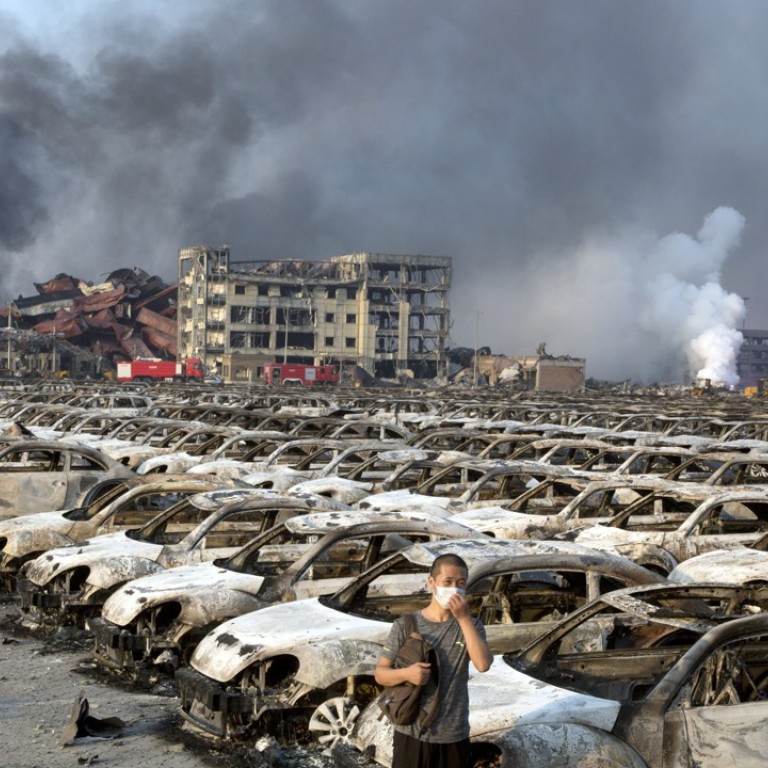
Has China really learned safety lessons after massive Tianjin chemical warehouse explosions?
Thousands of firms produce and store hazardous chemicals across the country, but only six provinces make their information available to public, NGO finds
It was not until the Binhai new district in Tianjin in northern China was rocked with deadly blasts last August that many people living in the area had even the first inkling that they were living next to a warehouse storing more than 11,000 tonnes of chemicals and hazardous goods.
The authorities have since concluded an official investigation into one of the country’s worst industrial disasters, with 165 confirmed dead and eight still officially classed as missing after the explosions.
It recommended that 123 government employees be punished for offences including dereliction of duty.
READ MORE: Deadly Tianjin warehouse explosion: review leads to China moving 10 chemical plants
The question remains, however, over whether China has really learned lessons from the Tianjin blasts as there are still several thousand enterprises across the country involved in producing and storing hazardous chemicals.

Investigators blamed more than 10 government departments for their role in the disaster – from work safety and environmental protection officials, to customs, the police and planners – for failing to supervise and oversee the dangerous goods warehouse.
It also ruled that legal loopholes and lax implementation of regulations had contributed to the disaster.
READ MORE: Punishment looms for Tianjin explosion executives
A local NGO in Shanghai has been trying to map the risks of hazardous chemical companies in China.
Liu Chunlei, the head of Qingyue Environmental Information, said transparency was the crucial first step towards effective supervision.
But to his dismay, Liu found that only six provinces had made chemical companies’ information available to the public.
Even in these six provinces, the information on the type and amount of chemicals used or stored was not complete. Also, few provinces made clear it where their enterprises were located, according to Liu.

Firefighters arrived at the Tianjin blasts site not knowing what was burning and this was one of the probable causes of the high number of casualties during the disaster.
Ninety-nine of the 165 confirmed killed were firefighters. They also account for five of the eight still missing.
It was not until three days after the blasts that Tianjin officials admitted that 700 tonnes of highly toxic sodium cyanide was missing.
Rescuers failed to retrieve 320 tonnes of chemicals, which had degraded into the air, water and soil, according to the official investigation.
Such information is critical to make the public aware whether the neighbourhood they’re living in is safe
The explosion was triggered when the flammable chemical nitrocellulose self-ignited at the warehouse in hot weather.
Investigators later found out that Ruihai International Logistics was storing 111 types of dangerous goods in its warehouse, and that the amount of the chemicals was far in excess of what it was permitted to store.
The inquiry also ruled that the chemicals had not been stored in a safe manner.
The blasts have led to air, water and soil pollution near the warehouse and the long-term impact will need further monitoring.
The official report blamed Ruihai chairman Yu Xuewei for bribing transport officials to gain permits for the business, and Dong Shexuan, the co-founder and son of a former police chief in Tianjin port, for using his father’s influence, to run the company.
The Tianjin transport commission approved the storage of hazardous chemicals before Ruihai passed safety and environmental assessments. Several safety assessors also colluded with the company, cooking up safety reports and “deliberately concealed safety problems”, according to the report.
While the Tianjin blasts was an extreme case, murky safety standards and chaotic management were persistent problems within the industry, the official investigation found.
READ MORE: Woman who lied about losing parents in Tianjin blasts – and scammed 96,500 yuan in donations – jailed for three years
Liu at the Shanghai-based NGO discovered that no province – even those which published information on chemical companies – gave details about their registered address or where the firms operate.
“In fact, the operational address of these companies, as well as the types and amount of chemicals in the companies, are much more important to public safety and health, as they allow residents to know if they’re living in a dangerous neighbourhood,” he said.
“But there was little of such information. I’m not sure if local governments don’t want to provide it or they simply don’t have it themselves,” said Liu.
Establishing a nationwide database could help all government departments become better informed about the operation of chemical companies, but it had to be made accessible to the public for better risk control, Liu said.

